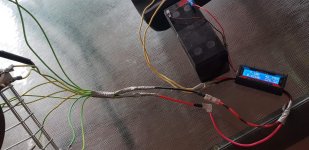Hello all
I have built a DIY battery capacity tester and as i’m not electrical engineer I wanted to run a few things by you before I test my good battery packs as there are a few things I don’t understand. I’m using a watt meter to measure the current flow.
The load is from oven, stove and oil heating elements. I am useless and describing things so I have attached pics - have I connected them optimally to maximise the load?
Currently the load varies depending on the battery. So at 40V it’s 4.7A and 188W. I know that’s V x A. With a higher voltage battery the amps are higher. Why is that? Is it that the higher voltage provides more power so I presume the elements will get hotter (motor would spin faster).
I tested a 36v 10ah battery that I bought 2nd hand from full 42v to 30v and the watt meter read 9.1ah. I'm happy with that but is there a calculation I could use to give me the ah of the pack but not have to strain it all the way down to 30v. I like to use my packs between 80% and 30%.
I know i’m going to sound like a right plonker with these questions but we all have to start somewhere.
I have built a DIY battery capacity tester and as i’m not electrical engineer I wanted to run a few things by you before I test my good battery packs as there are a few things I don’t understand. I’m using a watt meter to measure the current flow.
The load is from oven, stove and oil heating elements. I am useless and describing things so I have attached pics - have I connected them optimally to maximise the load?
Currently the load varies depending on the battery. So at 40V it’s 4.7A and 188W. I know that’s V x A. With a higher voltage battery the amps are higher. Why is that? Is it that the higher voltage provides more power so I presume the elements will get hotter (motor would spin faster).
I tested a 36v 10ah battery that I bought 2nd hand from full 42v to 30v and the watt meter read 9.1ah. I'm happy with that but is there a calculation I could use to give me the ah of the pack but not have to strain it all the way down to 30v. I like to use my packs between 80% and 30%.
I know i’m going to sound like a right plonker with these questions but we all have to start somewhere.




